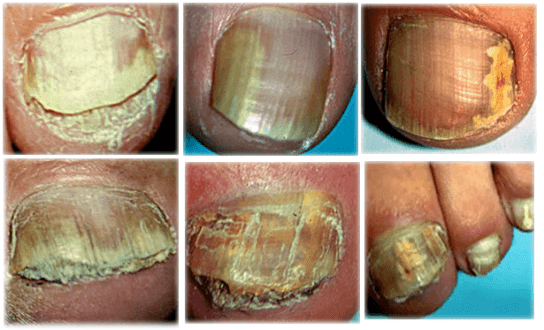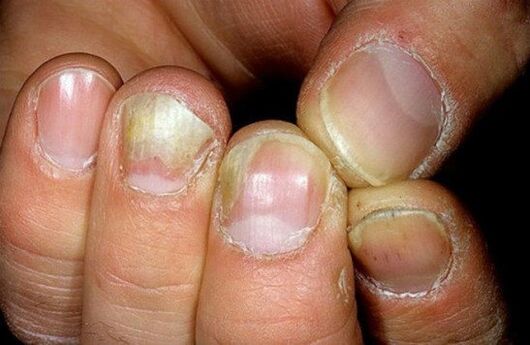Onychomycosis is an infectious disease of the nails caused by pathogenic fungi. According to statistics, it happens to every tenth person on Earth. About one third of all nail pathologies are fungal infections. More than 30% of cases occur in patients over the age of 65. Toenail fungus is 3-5 times more common than on the hands.
Causes of onychomycosis on nails
The disease begins with an infection of the nail plate, which often occurs in public places - swimming pools, saunas and baths. Scales with pathogenic spores fall on the floor, benches, paths and carpets. A moist and warm environment allows fungus to live and multiply, especially on unpainted wooden objects. Wearing tight shoes increases the chance of infection.
If one of the family members is sick, then there is a high risk of disease transmission through towels, carpets or grates in the bathroom. Fingernails become infected especially when brushing the affected skin area. The risk of disease increases with repeated nail injuries, decreased blood circulation in the feet and with severe comorbidities (diabetes, AIDS, systemic blood diseases).
Symptoms and types of onychomycosis

There are three forms of the disease - atrophic (onycholytic), normotrophic and hypertrophic onychomycosis. Characteristic symptoms are:
- the appearance of white or yellowish spots in the thickness of the nail plate;
- inflammatory process in the periungual roller;
- nail atrophy with separation from the bed;
- dystrophic process in the nail plate.
With atrophic onychomycosis, the nail plate becomes gray-brown, atrophies and separates from the bed. A loose layer forms on exposed areas. The hypertrophic form is characterized by subcutaneous hyperkeratosis, which causes pain when walking, changes in shape and destruction of the nail. The nail plate becomes dull and thickened. With normotrophic onychomycosis, the nail does not thicken and retains its shine. Stripes and spots appear on the nail plate, changing its color.
Nail fungus treatment
Onychomycosis begins to be treated immediately after diagnosis, because the infection develops quickly. Therapy with local antifungal drugs is only effective in the early stages. With the progression of the disease, the use of systemic agents is necessary.
In order for the systemic treatment of toenail fungus to be safe and effective, some rules must be followed:
- Therapy can be started only after confirming the diagnosis and consulting a doctor, because antifungal agents have some serious side effects. Self-selecting the dose is not acceptable.
- During treatment with systemic antimycotics, the use of other drugs, except for essential ones, should be limited.
- The affected nail area should be removed after softening it with a keratolytic patch.
- To avoid digestive disorders during the treatment period, foods that can cause flatulence are excluded from the diet - black bread, dairy products, cabbage, beans.
- You need to choose comfortable shoes that will not squeeze your feet.
Nail onychomycosis treatment at home
Traditional medicine offers several recipes for drugs that will help speed up recovery, but they can only be used in combination with the main treatment.
- Treat the affected nail 2 times a day with a 5% iodine solution. During application, a slight burning sensation should be noted. With severe pain, treatment should be stopped.
- To facilitate the separation of infected nails and increase regeneration, propolis dye 20% is used, which is applied to the lesions 2-3 times a day.
- Take a small piece of kombucha and apply it to the toenail that has been washed and steamed. Leave overnight, remove in the morning, rinse with water and remove the soft nail area. Treat the affected area with an antiseptic. The course of treatment is 2-3 weeks.
- Grate a head of garlic and make a compress, apply the gruel on the infected nail for 10-15 minutes.
Prevention and prognosis of nail onychomycosis
To avoid this disease, you should observe personal hygiene, do not use other people's clothes, shoes and towels. In the bathroom, pool and sauna, walk only in slippers, avoiding contact with potential places of accumulation of pathogens (wooden pallets and carpets). You need to wear comfortable shoes, avoid damage to the nails and fight excessive sweat on the feet.
The prognosis is good, depending on the severity of the disease, complete recovery takes from a few weeks to a year. The effect of therapy is enhanced when damaged nails are removed. Re-infection is possible if personal hygiene rules are not followed.
Pictures



















